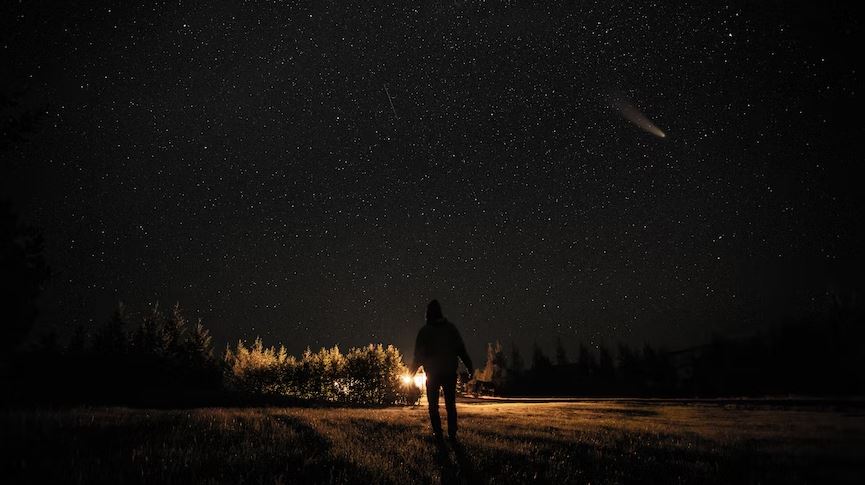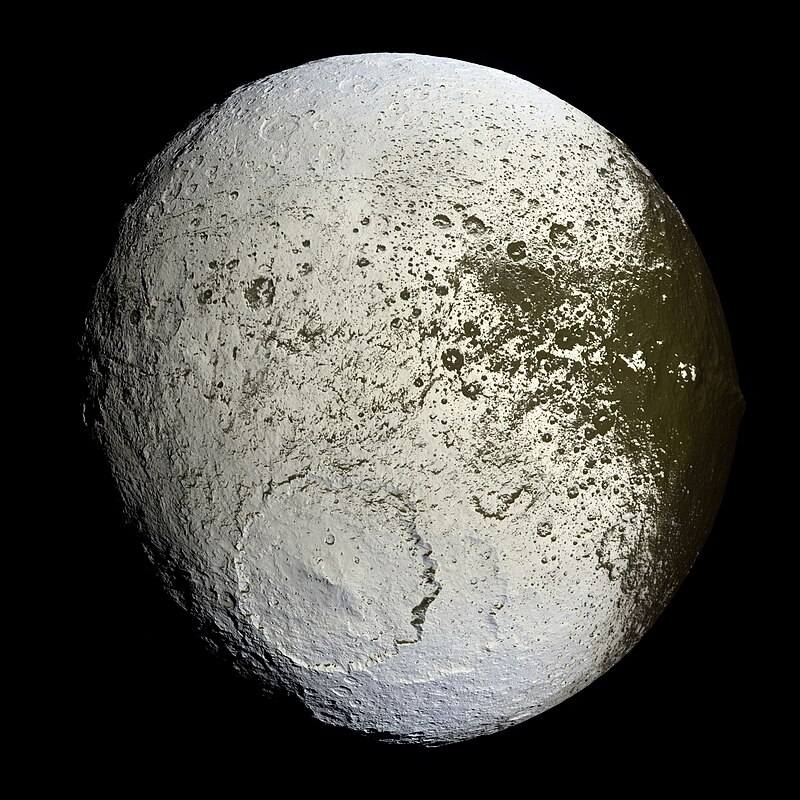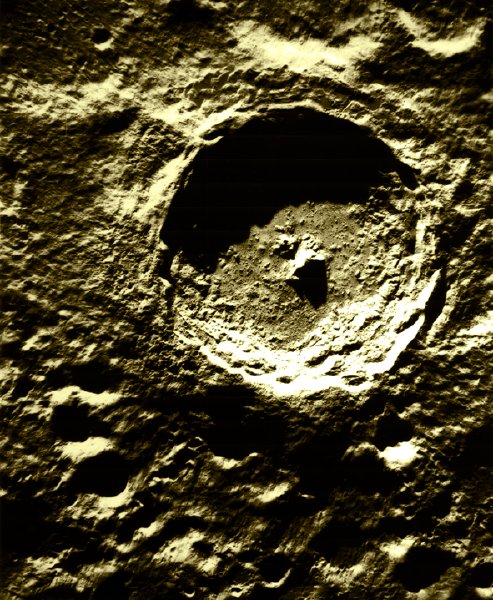Imagine enjoying a night of stargazing and suddenly wondering how these celestial bodies in the sky hang in there and what might happen when they hit the Earth. Now that’s a dreadful but exciting thought of a formation when a celestial body, such as a meteorite or asteroid, collides with the surface of a planet or Moon. When this geological feature comes into shape, they are called impact craters.
What is an Impact Crater?
An impact crater is a bowl-shaped depressed surface of a planet, Moon, asteroid, or other celestial body caused by the high-speed collision of a solid object, usually a meteorite or asteroid. These craters vary in size and shape, from small shallow depressions to large deep holes. For example, rocks collected during the Apollo missions have microscopic craters measuring just 0.0001 millimeters in diameter. On the other hand, Mars’ Hellas Basin has a diameter of 2000 km, roughly the size of Alaska. The formation of impact craters is a gravitational process involving immense energy and can significantly impact the surrounding environment.
How is an Impact Crater formed?
Impact craters are formed when asteroids, comets, or meteoroids crash into the Earth’s surface at extremely high speeds. This object must travel at high-speed – several thousand miles per hour to form an impact crater. The formation of an impact crater involves several stages:
1. Contact
The process starts when a high-speed object, such as a meteorite or asteroid, collides with the surface of a celestial body. Contact is a reasonably short period when the meteor hits the surface and begins to transfer energy to the surrounding rock. The intense pressure generated by the collision causes the impacted material to undergo rapid compression.
2. Excavation
During the excavation, the kinetic energy and shock waves generated by the impact cause the target material to be ejected outward and upward from the point of impact. This forms a temporary cavity known as the transient crater. Some surrounding rocks may even melt or evaporate because of the vital energy transfer.
During this phase, a significant amount of material is moved and thrown outward, creating a central lifting mound in the center of the developing crater. Shock waves can form cone-shaped cracks in rock, known as shatter cones. A shatter cone is one-way scientists can verify the impact crater on Earth.
3. Modification
The modification stage is the last in creating an impact crater. As the ejected material falls back onto the surface, it makes a continuous process of movement and adjustment of the material. This results in the final shape of the crater, which includes a central raised mound, raised rim, and an outer edge or wall that can be many times the diameter of the temporary crater. Most effects at this stage are due to gravity. However, larger craters experience an upward force at this point at their center.
Major Parts of an Impact Crater
The formation of an impact crater involves several distinct parts, each with its characteristics. Here are the main parts of an impact crater:
1. Floor
This is the base part of the crater, bowl-shaped or flat, and is usually below the surrounding ground. It can vary in elevation and may contain features such as central peaks, uplifted rings, or secondary craters formed by the impact debris.
2. Central Peaks
A central peak may form at the crater’s center in larger craters. This peak is produced by the rebound of the material on impact and can rise significantly from the bottom of the hole. The collapse of material in the crater causes the mound to grow to form the central peak. At the same time, the rock below the crater rebounds or bounces back to add to the peak part.
3. Walls
The inner parts of a crater, often steep, are called walls. They may have giant stair-like terraces created by the sagging of the walls due to gravity. The wall is the sloping surface that descends from the crater’s rim to the crater’s bottom. This part of the crater is typically steep and may have stepped features due to the material collapsing on impact.
4. Rim
The rim is the crater’s edge, which is a crater’s protruding circular or elliptical outer edge. It is formed by the material being pushed outward and upward during the impact event. It is elevated above the surrounding terrain because it is made of material pushed to the edge during excavation. The rim is usually the highest part of the crater and can vary in height and projection depending on the size and speed of the impactor.
5. Ejecta
Ejecta refers to material ejected from the impact site and deposited around the crater. This material can include rocks, dirt, and other debris. Ejecta blankets can extend considerable distances from the hole and are often layered, with the youngest layers closest to the rim.
6. Rays
The bright trails extending from the crater, sometimes at great distances, include the composition of ejecta material. Rays are long streaks of matter radiating outward from certain impact craters. These rays are formed by the ejection of lighter-colored weight, such as crushed rock or fine dust, contrasting with the surrounding darker terrain.
Famous Impact Craters
1. Meteor Crater (Earth)
The Meteor Crater, also known as Barringer Crater in Arizona, USA, was the first crater discovered to have been formed by a celestial impact. It was formed 50,000 years ago from a meteorite that could grow about 150 feet wide and travel at 28,000 mph. It is considered one of the best-preserved impact craters on Earth and is a significant scientific site for studying impact processes and planetary geology.
2. Tycho Crater (Moon)
Tycho Crater is a prominent impact crater located on the Moon. It is located in the Moon’s southern hemisphere, making it easily visible from Earth. Experts believed it to be about 108 million years old – young, by moon standards. Tycho Crater is named after the Danish astronomer Tycho Brahe.
3. Vredefort Crater (Earth)
The Vredefort crater is the largest known impact crater on Earth, almost 200 miles in diameter. It was located in the Free State province of South Africa around 2 billion years ago during an asteroid impact event, thus considered one of the oldest impact structures on our planet.
Common Types of Craters
Here are some types of impact craters based on their features:
1. Simple Craters
Simple craters are relatively small bowl-shaped craters with smooth walls (maximum size limit depends on the planet). Examples include the Barringer Crater (Meteor Crater) in Arizona, USA.
2. Complex Craters
Complex craters are larger and more complex in structure than simple craters. They often have central peaks, stepped walls, and more varied surface features. The Clearwater Lakes in Quebec, Canada, and Copernicus on the Moon are examples of complex craters.
3. Impact Basins
Impact basins are massive impact structures over 300 kilometers. The Moon has the largest impact basin, about 2500 kilometers in diameter with more than 12 kilometers deep. Mars and Mercury also have enormous impact basins.
4. Multi-Ring Basins
They are large impact structures with many concentric rings. The largest impact basins on planets and moons often exhibit multi-ring structures- as many as five or six circular rings of mountain chains on top of the central basin rim.
5. Irregular Craters
Craters with irregular formation or multiple impact crater shape simultaneously is another type of impact crater called irregular craters. Elongated craters can be created by impacts acting on the surface at a shallow angle.
Conclusion
Impact craters are some of the most distinct and exciting geological features on many planetary bodies in our solar system and beyond. They play an essential role in understanding the history of planets. By studying these features, scientists can determine the age of the surface and estimate the energy and size of the object that made the contact impact while gaining information about the geology and composition of the target material. These pieces of information led the way to discover more of the evolution of different planets and the unimaginable formation.





